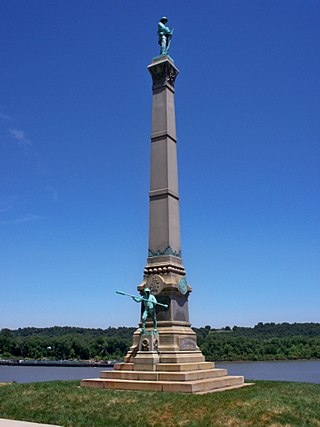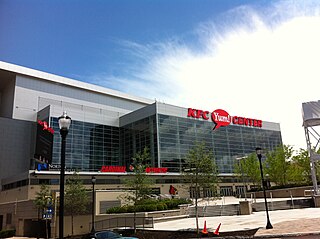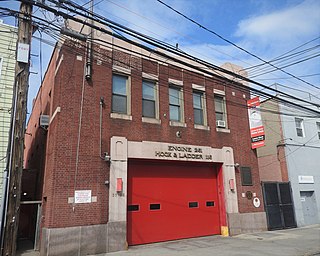
Louisville is the most populous city in the Commonwealth of Kentucky, sixth-most populous city in the Southeast, and the 27th-most-populous city in the United States. By land area, it is the country's 24th-largest city, although by population density, it is the 265th most dense city. Louisville is the historical county seat and, since 2003, the nominal seat of Jefferson County, on the Indiana border.

Barbourmeade is a home rule-class city in Jefferson County, Kentucky, United States. It was formally incorporated by the state assembly in 1962. The population was 1,216 as of the 2020 census, stagnant from 1,218 at the 2010 census.

Kentucky Educational Television (KET) is a state network of PBS member television stations serving the U.S. Commonwealth of Kentucky. It is operated by the Kentucky Authority for Educational Television, an agency of the Kentucky state government, which provides more than half of its annual funding. KET is the dominant public broadcaster in the commonwealth, with transmitters covering the vast majority of the state as well as parts of adjacent states; the only other PBS member in Kentucky is WKYU-TV in Bowling Green. KET is the largest PBS state network in the United States; the broadcast signals of its sixteen stations cover almost all of the state, as well as parts of Illinois, Indiana, Missouri, Ohio, Tennessee, Virginia, and West Virginia. The network's offices, network center, and primary studio facilities are located at the O. Leonard Press Telecommunications Center on Cooper Drive in Lexington; KET also has production centers in Louisville and at the Kentucky State Capitol Annex in Frankfort.

The Confederate Monument in Louisville is a 70-foot-tall monument formerly adjacent to and surrounded by the University of Louisville Belknap Campus in Louisville, Kentucky, United States. Relocation of the monument to Brandenburg, Kentucky, along the town's riverfront began November 2016, and was completed in mid-December. The granite and bronze structure was erected in 1895 by the Muldoon Monument Company with funds raised by the Kentucky Woman's Confederate Monument Association. The monument commemorates the sacrifice of Confederate veterans who died in the American Civil War.

The KFC Yum! Center is a multi-purpose indoor arena in Downtown Louisville, Kentucky, United States. It is named after the KFC restaurant chain and Yum! Brands, the parent company of KFC. Adjacent to the Ohio River waterfront, it is located on Main Street between 2nd and 3rd Streets and opened on October 10, 2010. The arena is part of a $450 million project that includes a 975-car parking structure and floodwall.

The Louisville Metro Police Department (LMPD) began operations on January 6, 2003, as part of the creation of the consolidated city-county government in Louisville, Kentucky, United States. It was formed by the merger of the Jefferson County Police Department and the Louisville Division of Police. The Louisville Metro Police Department has been headed by Jacquelyn Gwinn-Villaroel since January 2, 2023. LMPD divides Jefferson County into eight patrol divisions and operates a number of special investigative and support units. The LMPD is currently negotiating a consent decree with the United States Department of Justice (DOJ) subsequent to a 2023 investigation by the DOJ that concluded that the LMPD engaged in a decades long pattern of civil rights abuses.
The government of Louisville, Kentucky, headquartered at Louisville City Hall in Downtown Louisville, is organized under Chapter 67C of the Kentucky Revised Statutes as a First-Class city in the state of Kentucky. Created after the merger of the governments of Louisville, Kentucky and Jefferson County, Kentucky, the city/county government is organized under a mayor-council system. The Mayor is elected to four-year terms and is responsible for the administration of city government. The Louisville Metro Council is a unicameral body consisting of 26 members, each elected from a geographic district, normally for four-year terms. The Mayor is limited to a two consecutive term limit, while members of the Louisville Metro Council are not term limited.

The 800 Tower, formerly The 800 Apartments, is a 29-story residential skyscraper in Louisville, Kentucky, located in the city's SoBro neighborhood, nestled between Old Louisville and downtown. At the time construction was complete in 1963, The 800 was the tallest building in Louisville, a record it maintained for nearly a decade.

Louisville Metro Emergency Medical Services is the primary provider of pre-hospital life support and emergency care within Louisville-Jefferson County, Kentucky. LMEMS is a governmental department that averages 90,000 calls for service, both emergency and non-emergency, each year.

Louisville City Hall is a registered historic building in Louisville, Kentucky, placed on the National Register of Historic Places in 1976. Completed in 1873 to house the Louisville city government, the structure is located at 601 West Jefferson Street in what became Downtown Louisville, the center of the city's civic district.
Rebecca Jackson is a former Republican politician from Louisville, Kentucky. She previously served as the Jefferson County Judge/Executive and also ran unsuccessfully for the Republican party nomination for governor. She is the former chief executive officer of the WHAS Crusade for Children, a local charity that operates a large annual telethon. She is retired from CEO of Mastery Mavens, an internet-based professional development tool for teaching professionals.
Huston Quin was mayor of Louisville, Kentucky from 1921 to 1925.

Melville F. Whedbee was an American college football player and coach. He served as the head football coach at Kentucky State University in Frankfort, Kentucky from 1961 to 1966. Whedbee joined the coaching staff at Kentucky State in 1959 as an assistant under Sam B. Taylor. He took over as head coach for an ailing Taylor midway through the 1961 season. Whedbee was succeeded as head football coach by Charles Bates in 1967, but remained as an instructor in the physical education department at Kentucky State.

The Historic Firehouses of Louisville is a Thematic Resource (TR) Multiple Property Submission (MPS) on the National Register of Historic Places. The submission represents 18 historic fire stations, located in Louisville, Kentucky, which were added to the National Register in 1980–81 due to their historical and architectural merits.

Colonial Gardens is a restaurant complex and local landmark located in the Kenwood Hill neighborhood of Louisville, Kentucky, across New Cut Road from Iroquois Park. It was formerly an entertainment complex, and in its earliest existence, a part of Senning's Park, the site of the first zoo in Louisville.

The Old Brooklyn Fire Headquarters is a historic building located at 365-367 Jay Street near Willoughby Street in Downtown Brooklyn, New York City. Designed by Frank Freeman in the Richardsonian Romanesque Revival style and built in 1892 for the Brooklyn Fire Department, it was used as a fire station until the 1970s, after which it was converted into residential apartments. The building, described as "one of New York's best and most striking architectural compositions", was made a New York City landmark in 1966, and listed on the National Register of Historic Places in 1972.

Gregory Edward Fischer is an American businessman and entrepreneur who served as the second mayor of Louisville Metro from 2011 to 2023. In 2019, he was elected vice president of the U.S. Conference of Mayors, and in 2020, he served as its president.
Richard Wilson is a retired American basketball player. He played for the Atlanta Hawks of the National Basketball Association (NBA) from 1978 to 1980.

Firehouse, Engine Company 261 and Ladder Company 116 is a New York City Fire Department firehouse at 37-20 29th Street in Long Island City, Queens, New York City. The firehouse was originally built in 1932 for Engine Company 261 and Ladder Company 116.

The Breonna Taylor protests were a series of police brutality protests surrounding the killing of Breonna Taylor. Taylor was a 26-year-old African-American woman who was fatally shot by plainclothes officers of the Louisville Metro Police Department on March 13, 2020. Police were initially given "no-knock" search warrant, but orders were changed to "knock and announce" before the raid. Taylor's boyfriend, Kenneth Walker, who was inside the apartment with her during the raid, said he thought the officers were intruders. He fired one shot, hitting officer Mattingly in the leg, and the officers fired 32 shots in return, killing Taylor.

















